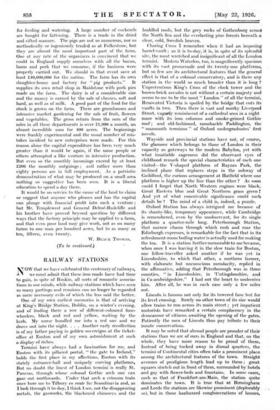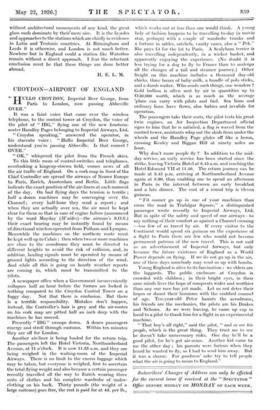RAILWAY STATIONS
NOW that we have celebrated the centenary of railways, we must admit that these iron roads have had time to gain, in spite of Ruskin, all sorts of romantic associa- tions in our minds, while railway-stations which have seen so many partings and reunions can no longer be regarded as mere necessary evils of which the less said the better.
One of my own earliest memories is that of arriving at King's Bridge Station, Dublin, on a winter's evening, and of finding there a row of different-coloured four- wheelers, black and red and yellow, waiting by the kerb. My nurse bundled me into a red one and we drove out into the night ¬her early recollection is of my father paying in golden sovereigns at the ticket- office at Euston and of my own astonishment at such a display of riches. Termini have always had a fascination for me, and Euston with its pillared portal, " the gate to Ireland," holds the first place in my affections, Euston with its stately entrance-hall and uniquely curving platforms. But no doubt the finest of London termini is really St. Pancras, through whose colossal Gothic arch one can gaze out northwards. Under that arch a crimson train once bore me to Tilbury en route for Scandinavia and, as I look through it to-day, I think I see, not the disappearing metals, the gasworks. the blackened chimneys and the huddled roofs, but the grey rocks of Gothenburg across the North Sea and the everlasting pine forests beneath a clear, cold, Swedish heaven.
Charing Cross I remember when it had an imposing barrel-vault ; as it is to-day, it is, in spite of its splendid site, the most wretched and insignificant of all the London termini. Modern Waterloo, too, is magnificently spacious_ with its vast promenade and its twenty-one platforms, but so. few are its architectural features that the general effect is that of a colossal conservatory, and is there any station in the world so much broader than it is long ? Unpretentious King's Cross of the clock tower and the brown-brick arcades is not without a certain majesty and seems to me to be the most " London " of all the termini.1 Renovated Victoria is spoiled by the bridge that cuts its vaults in two. Then there is vast and murky Liverpool Street, vaguely reminiscent of a cathedral seen in a night mare with its iron columns and smoke-grimed Gothic roof ; and old-fashioned, ramshackle Paddington, the " mammoth terminus " of Oxford undergraduates' first • novels.
Wayside and provincial stations have not, of course, the glamour which belongs to those of London in their capacity as gateways to the modern Babylon, yet with what insatiable eagerness did the observant eyes of childhood remark the special characteristics of each one visited—the V-shaped platform of Baynes Park, the inclined plane that replaces steps in the subway of Guildford, the curious arrangement at Hatfield where one platform is higher up the line than the other ? As soon could I forget that North Western engines were black, Great Eastern blue and Great Northern grass green ! And yet of what conceivable significance could such details be ? The mind of a child is, indeed, a puzzle.
Oxford Station has always intrigued me because of its shanty-like, temporary appearance, while Cambridge is remembered, even by the unobservant, for its single platform a quarter-mile long. Peterborough Station, that narrow chasm through which rush and roar the Edinburgh expresses, is remarkable for the fact that in its refreshment-room boiling water is actually used for making the tea. It is a station further memorable to me because, when once I was leaving it in the slow train for Boston, one fellow-traveller - asked another if he was yet in Lincolnshire, to which that other, a northern -farmer, with elaborate but unconscious mendacity, replied in the affirmative, adding that _Peterborough was in three counties, " in Lincolnshire, in 'Untingdonshire, and in Ca-ambridgeshire." I had not the heart to undeceive him. After all, he was in each case only a few miles out.
Lincoln is famous not only for its towered fane but for its level crossing. Surely no other town of its size would allow trains to rim across its main street ; yet impatient motorists have remarked a certain complacency in the demeanour of citizens awaiting the opening of the gates. Patiently the men of Lincoln thus pay tribute to their innate conservatism.
It may be noted that abroad people are prouder of their stations than we arc of ours in England and that, of the whole, they have more reason to be proud of them. Instead of being tucked away in dismal quarters, the termini of Continental cities often take a prominent place among the architectural features of the town. Straight avenues of prodigious length lead up to them ; great squares stretch out in front of them, surrounded -by hotels and gay with flower-beds and fountains. In some cases, such as that of Frankfurt-am-Main, the station quite dominates the town. It is true that at Birmingham • and Leeds the stations are likewise prominent (deplorably so), but in those haphazard conglomerations of houses. without architectural monuments of any kind, the great glass roofs dominate by their.mere size. It is the façades and approaches to the stations which are chiefly in evidence in Latin and Teutonic countries. At Birmingham and Leeds it is otherwise, and London is not much better. Nowhere but in England could a station like Waterloo remain without a direct approach. I fear the reluctant conclusion must be that these things are done better abroad.
H. E. L. M.















































 Previous page
Previous page